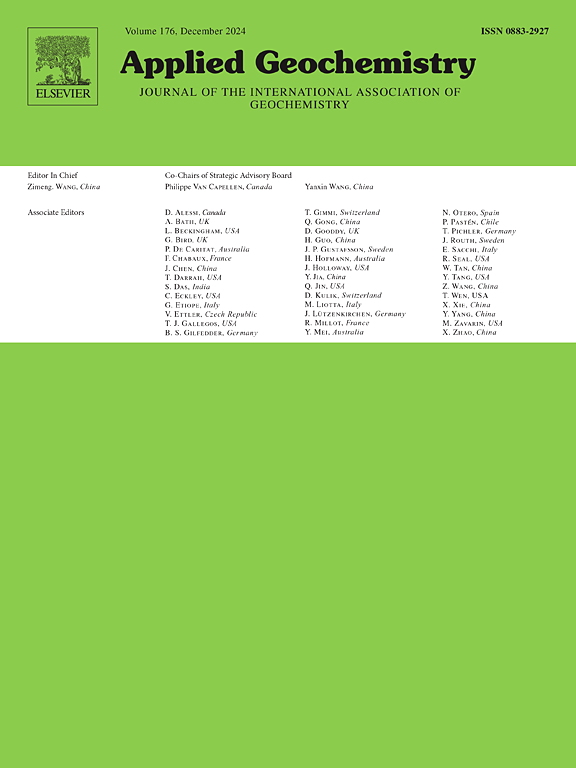Elevated mercury (Hg) in groundwater caused by oil and gas production
IF 3.1
3区 地球科学
Q1 GEOCHEMISTRY & GEOPHYSICS
引用次数: 0
Abstract
Between 1965 and 2017, the Port Harcourt Refining Company (PHRC) refined crude oil in the eastern Niger Delta and groundwater hydrocarbon contamination in the area is known. However, nothing is known about the concentration, source, speciation and mobility of mercury (Hg), a potential byproduct of oil refining. To address this, groundwater samples were collected along the wastewater discharge outlet (WDO) and around the PHRC. The Hg concentrations in groundwater near the WDO varied between 0.2 and 6 μg/L, compared to less than 0.01 μg/L at distances greater than 300 m from the WDO and reference sites away from the refinery. Up to 63 % of Hg were present as Hg bound to particles larger than 0.45 μm (Hgpart), suggesting the prevalence of Hg transport in the suspended colloidal phase in the aquifer. Operational-defined Hg speciation shows that 33 % of the total Hg (THg) occurred as inorganic, reactive Hg2+. In comparison, only 4 % occurred as dissolved organic matter-bound Hg2+ despite high DOC and BTEX concentrations of up to 47 mg/L and 2888 μg/L, respectively. Notably, the DOC is predominantly petroleum hydrocarbon, generated from the ongoing oil and gas activities at the site. This suggests that hydrocarbon-based-DOC does not bind Hg.
Sediment samples collected from the wastewater discharge point (WDP) contained Hg concentrations of up to 529 μg/kg, and the carbon (C) content reached 40 %. Sediment batch leaching experiments showed that up to 23.5 % of the Hg in the quartz-dominant sediment can be mobilized into groundwater under oxic conditions. Despite the presence of petroleum hydrocarbon, Hg retention was significantly controlled by the sediment's natural organic matter (NOM). Hence, the discharged oil and gas production wastewater due to crude oil refining released Hg into the aquifer, where NOM ultimately controls fate and transport.

石油和天然气生产导致地下水中汞含量升高
1965年至2017年间,哈科特港炼油公司(PHRC)在尼日尔三角洲东部精炼原油,该地区的地下水碳氢化合物污染是已知的。然而,人们对汞(Hg)的浓度、来源、形态和流动性一无所知,汞是炼油的潜在副产品。为了解决这个问题,地下水样本沿着污水排放出口(WDO)和PHRC周围收集。WDO附近的地下水汞浓度变化在0.2 ~ 6 μg/L之间,而距离WDO和远离炼油厂的参考地点超过300 m的地下水汞浓度低于0.01 μg/L。高达63%的汞以汞结合在大于0.45 μm (Hgpart)的颗粒上的形式存在,表明汞在含水层的悬浮胶体相中普遍存在。操作定义的汞形态表明,33%的总汞(THg)以无机活性Hg2+的形式出现。相比之下,尽管DOC和BTEX浓度分别高达47 mg/L和2888 μg/L,但只有4%以溶解有机质结合的Hg2+形式出现。值得注意的是,DOC主要是由现场正在进行的石油和天然气活动产生的石油碳氢化合物。从污水排放点(WDP)采集的沉积物样品中,汞浓度高达529 μg/kg,碳(C)含量达到40%。沉积物批量浸出实验表明,在氧化条件下,石英为主的沉积物中高达23.5%的汞可被动员到地下水中。尽管存在石油烃,但汞的滞留明显受沉积物天然有机质(NOM)的控制。因此,原油炼制过程中排放的油气生产废水将汞释放到含水层中,而NOM最终控制着含水层的命运和运移。
本文章由计算机程序翻译,如有差异,请以英文原文为准。
求助全文
约1分钟内获得全文
求助全文
来源期刊

Applied Geochemistry
地学-地球化学与地球物理
CiteScore
6.10
自引率
8.80%
发文量
272
审稿时长
65 days
期刊介绍:
Applied Geochemistry is an international journal devoted to publication of original research papers, rapid research communications and selected review papers in geochemistry and urban geochemistry which have some practical application to an aspect of human endeavour, such as the preservation of the environment, health, waste disposal and the search for resources. Papers on applications of inorganic, organic and isotope geochemistry and geochemical processes are therefore welcome provided they meet the main criterion. Spatial and temporal monitoring case studies are only of interest to our international readership if they present new ideas of broad application.
Topics covered include: (1) Environmental geochemistry (including natural and anthropogenic aspects, and protection and remediation strategies); (2) Hydrogeochemistry (surface and groundwater); (3) Medical (urban) geochemistry; (4) The search for energy resources (in particular unconventional oil and gas or emerging metal resources); (5) Energy exploitation (in particular geothermal energy and CCS); (6) Upgrading of energy and mineral resources where there is a direct geochemical application; and (7) Waste disposal, including nuclear waste disposal.
 求助内容:
求助内容: 应助结果提醒方式:
应助结果提醒方式:


